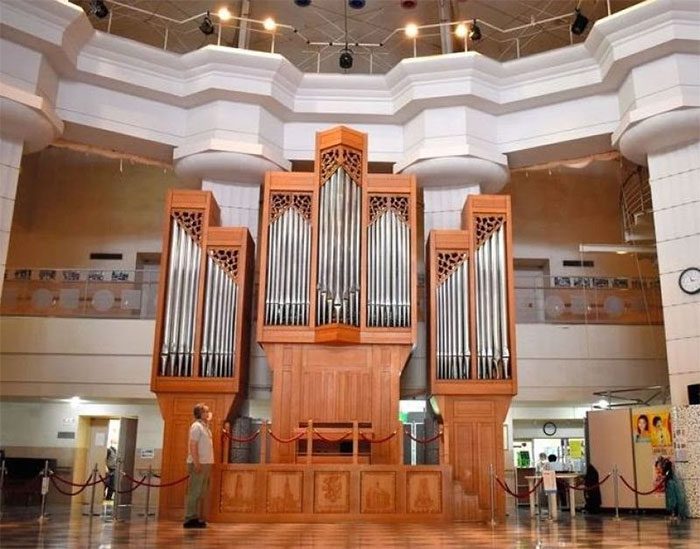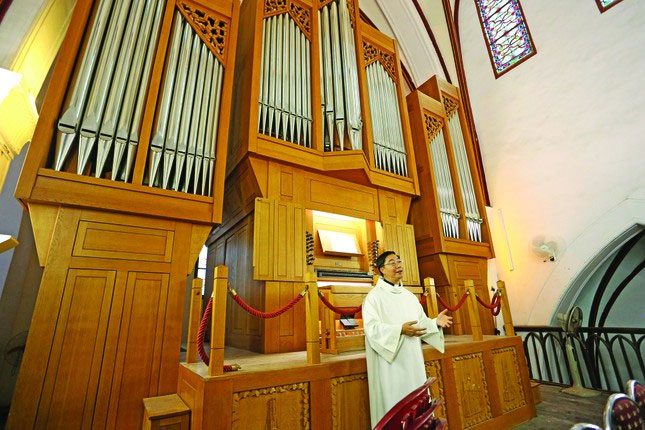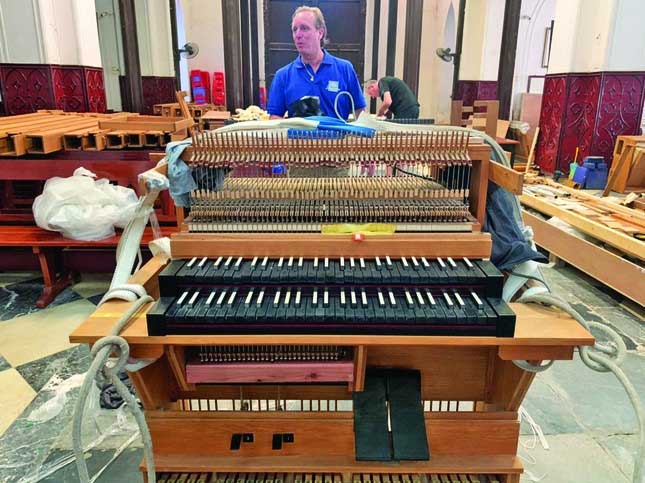The grand pipe organ, weighing 9 tons, standing 7 meters tall, 6.5 meters wide, and 4 meters deep, was produced by a company in Belgium and has just arrived in Vietnam from Japan, leaving many people in awe.
In Harmony with the Cultural and Religious Center of the Capital
During the Christmas season, we had a meeting with Father Anton Nguyen Van Thang, the Pastor of St. Joseph’s Cathedral in Hanoi. Despite the rainy and cold weather, Father Anton smiled joyfully as the church, under his care, had just received the grand pipe organ from Japan.
Pointing to the organ, Father Anton explained that this grand pipe organ was manufactured in 1993 at the Sun City Hall in Itami, Hyogo Prefecture, Japan, intended for the elderly. The instrument is a result of a cultural exchange between the cities of Itami (Japan) and Hansen (Belgium).
The organ was crafted by the Belgian instrument maker Guido Schumacher, featuring 1,696 pipes. It stands 7 meters tall, 6.5 meters wide, 4 meters deep, and weighs 9 tons. The materials for each part of the organ were selected to suit the climate of Itami specifically and the Asian region generally. At that time, the city of Itami purchased the organ for 70 million yen, equivalent to approximately 17 billion Vietnamese Dong.
According to Father Anton, this grand pipe organ experienced significant damage during the Kobe earthquake in 1995. The Itami senior citizens’ association had plans to restore the organ. In 2018, a company in Japan repaired the damaged parts, but the sound quality was no longer as precise as assessed by the manufacturing company (Schumacher). Subsequently, Schumacher proposed to restore the organ.
However, the cost to restore this grand pipe organ was estimated at around 250,000 euros, which the Itami senior citizens’ association could not afford. Over time, the maintenance and repair costs for this organ became too high, exceeding the budget allocated for senior welfare programs.

Grand pipe organ.
Therefore, the Itami city hall intended to liquidate and wanted to donate the organ to a Catholic church. However, most Catholic churches in Japan are small and low, making them unsuitable for this organ.
Coincidentally, Mr. Chikara Maruyama (75 years old), a piano repair specialist, learned of this story and contacted the city for assistance. He emailed 100 establishments, including churches, but did not receive the desired response. Undeterred, Maruyama used Google Maps to search for churches with architecture appropriate for this type of organ worldwide and found what he was looking for in Vietnam, where Catholic churches are built in Gothic architecture.
Upon learning this information, Father Peter Pham Hoang Trinh, who was ministering in Oita (Japan), offered to donate the organ to a church in Vietnam. Father Peter shared that this was a serendipitous moment when he went to celebrate Mass for Vietnamese children at the Tetorit parish in Sumato (Japan) and happened to meet Chikara Maruyama, the piano repair specialist. He talked to me about the city of Itami having the grand pipe organ that was no longer in use for various reasons and asked if there was a church in Vietnam that would like to receive the organ for use.
He also provided me with the website of the city. I opened it and saw that it was a wonderful organ—the first time in my life I had seen one. “After that, I looked at and posted pictures of the organ on Facebook, and 7 cathedral churches and 3 religious orders expressed interest. After consideration, St. Joseph’s Cathedral in Hanoi, with its Gothic architecture and its position as the cultural and religious center in the capital, was chosen, so the Itami city hall decided to donate the organ to this church,” Father Peter said.
Afterward, Father Anton and Father Peter sought the manufacturing company for assistance in dismantling, transporting, and installing the organ. After many efforts, the two priests managed to contact Schumacher, the company that produced the organ. The Director of Schumacher expressed joy and readiness to collaborate in dismantling the organ from Itami and installing it in Hanoi.

Father Anton Nguyen Van Thang introducing the organ. (Photo: M.D)
All the parts and accessories of the organ were carefully dismantled, packed into wooden boxes, then loaded into a container and shipped to Vietnam. The organ arrived at Hai Phong port and cleared customs on July 19, 2022. On the evening of July 21, the container carrying the grand pipe organ arrived at St. Joseph’s Cathedral in Hanoi.
When the organ was transferred to St. Joseph’s Cathedral, Schumacher cleaned the entire surface and refurbished 300 pipes. The costs for dismantling and restoration were covered by St. Joseph’s Cathedral, amounting to approximately 200,000 euros.
Bringing Forth Eternal Melodies
In a conversation with us, Father Anton Nguyen Van Thang stated that on the evening of November 23, 2022, St. Joseph’s Cathedral held a concert titled “Music of Praise to God” to celebrate the Archdiocesan Synod and the inauguration of the grand pipe organ.
The concert was attended by Archbishop Marek Zalewski, the non-resident representative of the Holy See in Vietnam, Archbishop Joseph Vu Van Thien, along with religious leaders, delegates, and the congregation.
Additionally, attendees included Mr. Yasuyuki Fujiwara, the Mayor of Itami, Japan; Father Peter Pham Hoang Trinh, the Vietnamese chaplain in Japan; Mr. Guido Schumacher, director of the manufacturing company; Mr. Ferdy Simon, the pipe organ sound engineer; and local officials.

Mr. Guido Schumacher – Director of the manufacturing company. (Photo: T.L).
Mr. Schumacher explained the organ’s unique structure, which took thousands of hours to complete. The artist using this organ is like conducting an orchestra with 27 different musicians. He emphasized that the organ represents a symbol of Christianity, with each pipe representing individual believers in the Church.
While differing in structure, all of them together create beautiful sounds. Mr. Schumacher pointed out to the congregation that the organ holds an important position in Catholic life, accompanying every significant event from baptisms, weddings, to funerals.
The organ also symbolizes international friendship and cultural exchange. He hopes that the grand pipe organ will serve as a symbol of friendship and a bright point in the relationship between Vietnam and Belgium. Mr. Guido Schumacher also presented the congregation with a heartfelt piece of music.
“We have refurbished around 300 pipes. I am very pleased to have installed and tuned the organ today. I hope this pipe organ will serve well for this beautiful church, supporting the singing and music for the liturgies and concerts. Through that, people can find peace to uplift their hearts to God and create a bond between God and humanity,” Mr. Ferdy Simon expressed.
| Engineer Ferdy Simon shared: “I am from the company that produced this organ; I installed it in Itami, and now I am very honored to install it again when it is transported here. Due to the earthquake, some pipes were damaged and had to be repaired.” |
Archbishop Joseph Vu Van Thien expressed hope that the organ will serve as a bridge connecting the cities of Itami and Hanoi, and the countries of Vietnam and Japan, as evidence of the precious friendship. Archbishop Joseph also had a commemorative gift to present to the Japanese officials.
“The concert program of music praising God took place in a sacred atmosphere with choral performances, organ solos, and woodwind quartets presented by choirs and artists. The words of gratitude to God resounded through song and music, as a tribute to the blessings God has bestowed upon the Archdiocese in general, St. Joseph’s Cathedral in particular, and especially the Synod of the Archdiocese.”
The grand pipe organ is a large instrument that produces sound by controlling pressurized air (wind) through selected pipes via a keyboard. This instrument is typically used in churches, theaters, and conference halls—places with large spaces and high ceilings. The grand pipe organ is one of the oldest instruments in Europe to date. Its predecessor was created in the 3rd century BC in ancient Greece. The sound of the grand pipe organ resonates most commonly in Christian churches and cathedrals. The Baroque period (1600 – 1700) was the most glorious time for this type of instrument.
Leave a Reply |


















































